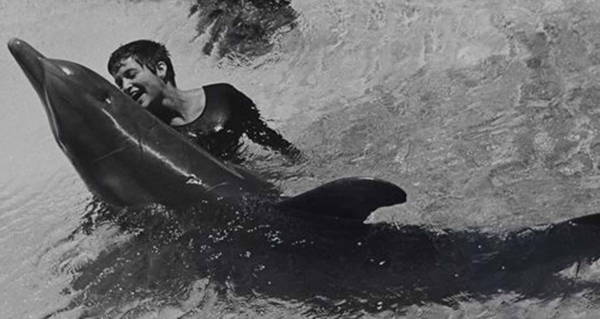Discover the remarkable story of Margaret Howe Lovatt’s unparalleled bond with a dolphin, born out of a NASA-funded experiment.
When a young Carl Sagan visited St. Thomas’ Dolphin Point laboratory in 1964, little did he know that he would witness an experiment that would stir controversy. Sagan, a member of the secretive group known as “The Order of the Dolphin,” was intrigued by the possibility of extraterrestrial intelligence. Among his comrades was the eccentric neuroscientist Dr. John Lilly, whose book Man and Dolphin ignited interest in interspecies communication. This led to an experiment that took an unexpected turn.
Trying To Connect Dolphins And Humans
At the National Radio Astronomy Observatory’s Green Bank Telescope, astronomer Frank Drake drew parallels between his own work and Lilly’s ideas. With Drake’s help, Lilly secured funding from NASA to create a bridge of communication between humans and dolphins. He established Dolphin Point, a laboratory on the picturesque Caribbean shore, complete with a workspace and a dolphin enclosure.
It was at this point that 23-year-old Margaret Howe Lovatt, driven by curiosity and a childhood fascination with talking animals, arrived at the lab. Lovatt’s involvement initially began with her simply observing the dolphins. However, her intuition and dedication to the project became apparent to both Lilly and Gregory Bateson, the lab’s director.
Margaret Howe Lovatt Becomes A Diligent Researcher
Lovatt soon became deeply involved in the experiment. She worked closely with three dolphins: Pamela, Sissy, and Peter. Lovatt’s goal was to teach them to produce human-like sounds through daily lessons. As progress seemed slow, Lovatt took extraordinary measures. She convinced Lilly to allow her to live in the lab, transforming the upper rooms into a submerged living space. This arrangement allowed humans and dolphins to share the same environment.
Peter, an adolescent dolphin, became Lovatt’s primary focus for language experiments. They spent six days a week together in the lab, with Peter only returning to the enclosure on the seventh day to join Pamela and Sissy. Through their interactions, Lovatt discovered Peter’s fascination with her anatomy. He would examine her knee, foot, and hand, attempting to understand how they functioned. Although Lovatt did not view these encounters as sexual, she allowed Peter to satisfy his sexual urges manually to maintain focus during their sessions.
The Beginning of the End
Meanwhile, Frank Drake, eager to assess the progress of the experiment, sent his colleague, a 30-year-old Carl Sagan, to Dolphin Point. Drake hoped to witness advancements in decoding dolphin language, but was disappointed by the lack of tangible results. This marked the turning point for Lilly and his project’s funding. Nonetheless, Lovatt’s bond with Peter continued to grow even as the project deteriorated.
By 1966, Lilly’s interest shifted from dolphins to the mind-altering effects of LSD. Lilly, fascinated by the drug’s potential, both dosed himself and the dolphins at the lab—excluding Peter, at Lovatt’s insistence. The dolphins proved impervious to LSD’s effects, but Lilly’s cavalier attitude toward their safety strained his relationship with Bateson and halted further funding for the lab.
Eventually, Lovatt’s time living with a dolphin came to an end. She remained in St. Thomas, married the project’s original photographer, and transformed the abandoned Dolphin Point laboratory into a family home. For nearly five decades, Lovatt rarely spoke about her experiences. However, she recently granted interviews for the documentary The Girl Who Talked to Dolphins.
